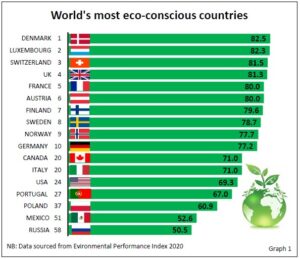The world’s most environmentally conscious countries
[GTranslate]To be environmentally-friendly or “green”, requires engagement in practices and processes that are sustainable and minimize harmful impacts on the environment. Some countries do it better than others.
According to the 2020 Environmental Performance Index (EPI), formulated by researchers at Yale and Columbia universities, Denmark is rated the “greenest” country in the world. The Nordic nation has the highest EPI score at 82.5. (see graph below)
The countries scoring among the top ten have one thing in common: they are all concentrated in Europe. The data-driven EPI is a method to quantify environmental performance of country’s policies. It measures the state of each nation’s sustainability and ranks 180 countries on environmental health and ecosystem vitality.
Each country is evaluated using thirty performance indicators across eleven categories. Several factors contribute to the overall index. These include climate change, air quality, habitat biodiversity, drinking water and sanitation.
The EPI score tracks each country’s environmental trends and progress. It can be a fundamental tool for governments to see how close they are to their environmental targets. It can also promote the creation of effective policies to reach those goals.
For example, climate change is a “hot topic”, one that Denmark takes seriously. It has some of the most efficient policies mitigate climate change and reduce green house gas emissions by 70% by the year 2030.
Creating an environmentally friendly planet will take a global effort. Canadians also care about their environment, and it shows. In 2020, Canada preformed relatively well at number twenty. It shares the position with Italy. Both countries scored an EPI of 71.
For Canada, it is an improvement from the twenty-fifth spot, two years ago. Some of this improvement could be credited to Canada’s commitment to reducing green house gas emissions. Under the Paris Agreement (an international treaty in which participating countries work to keep the global temperature rise below 2 ˚C with aims to limit the increase to 1.5 ˚C), Canada has committed to reducing greenhouse gas emissions 30% (before 2005 levels) by the year 2030.
One such method to achieve that goal and reduce pollution is through carbon pricing schemes. In Canada, the 2018 Greenhouse Gas Pricing Act is a national framework for carbon pricing. There are minimum pricing standards which provinces must meet.
On March 25, the Supreme Court of Canada (SCC) ruled that the federal carbon tax is constitutional. The Court ruled that the federal government has the power impose its own carbon tax on provinces that do not meet, or fall short of, national standards. However, it remains a point of contention with conservatives which argue the tax poses a burden on consumers and energy producers.
Carbon emissions are a significant driver of climate change. Despite the temporary drop in CO2 levels during lockdown measures implemented early 2020 to stem the spread of Covid-19 infections, CO2 emissions still continue to rise.
The environment and climate change knows no borders. The SCC’s decision to uphold the constitutionality of the federal government further suggests the nation has an obligation to pass and promote pro environment legislation for a greener, healthier tomorrow.




